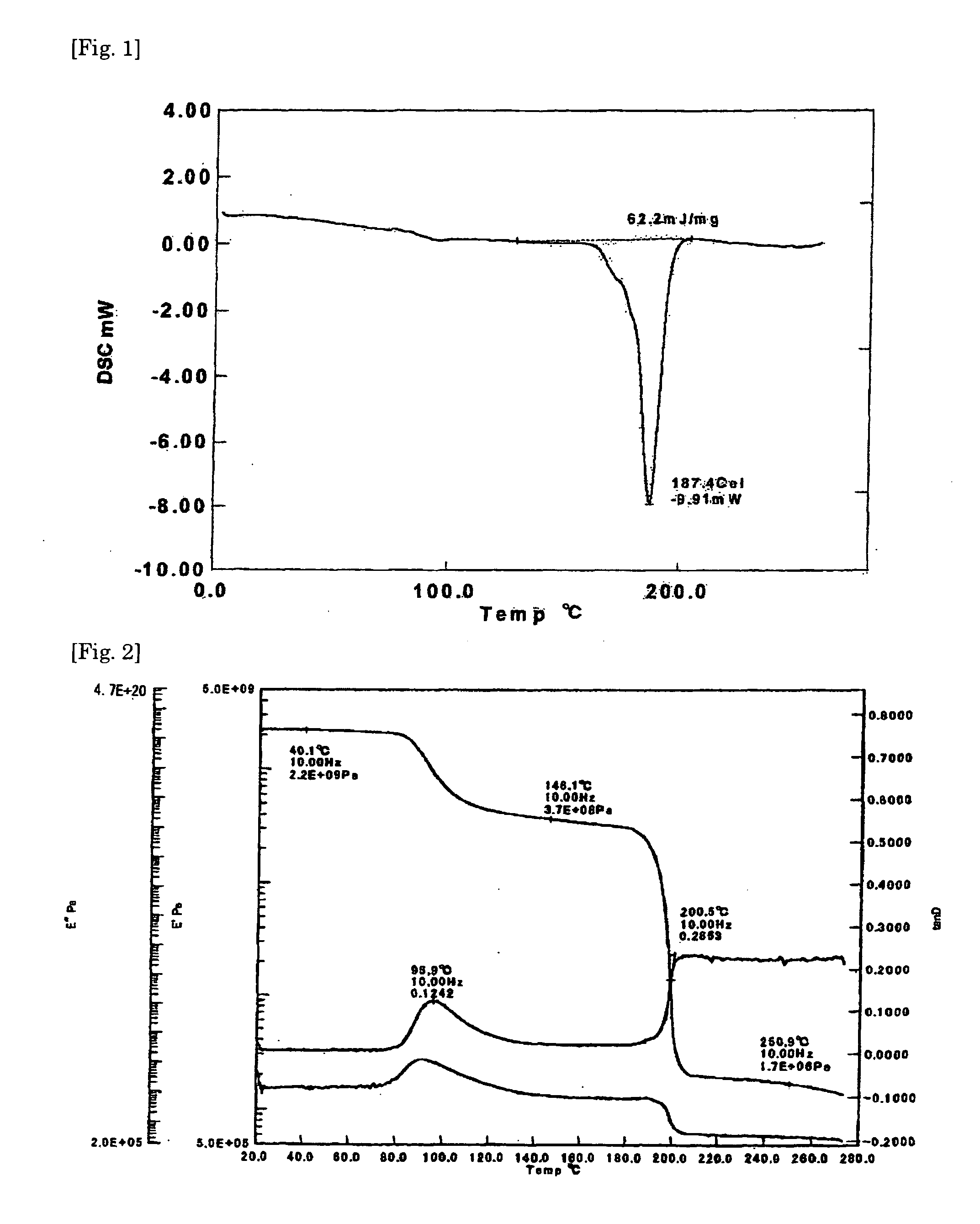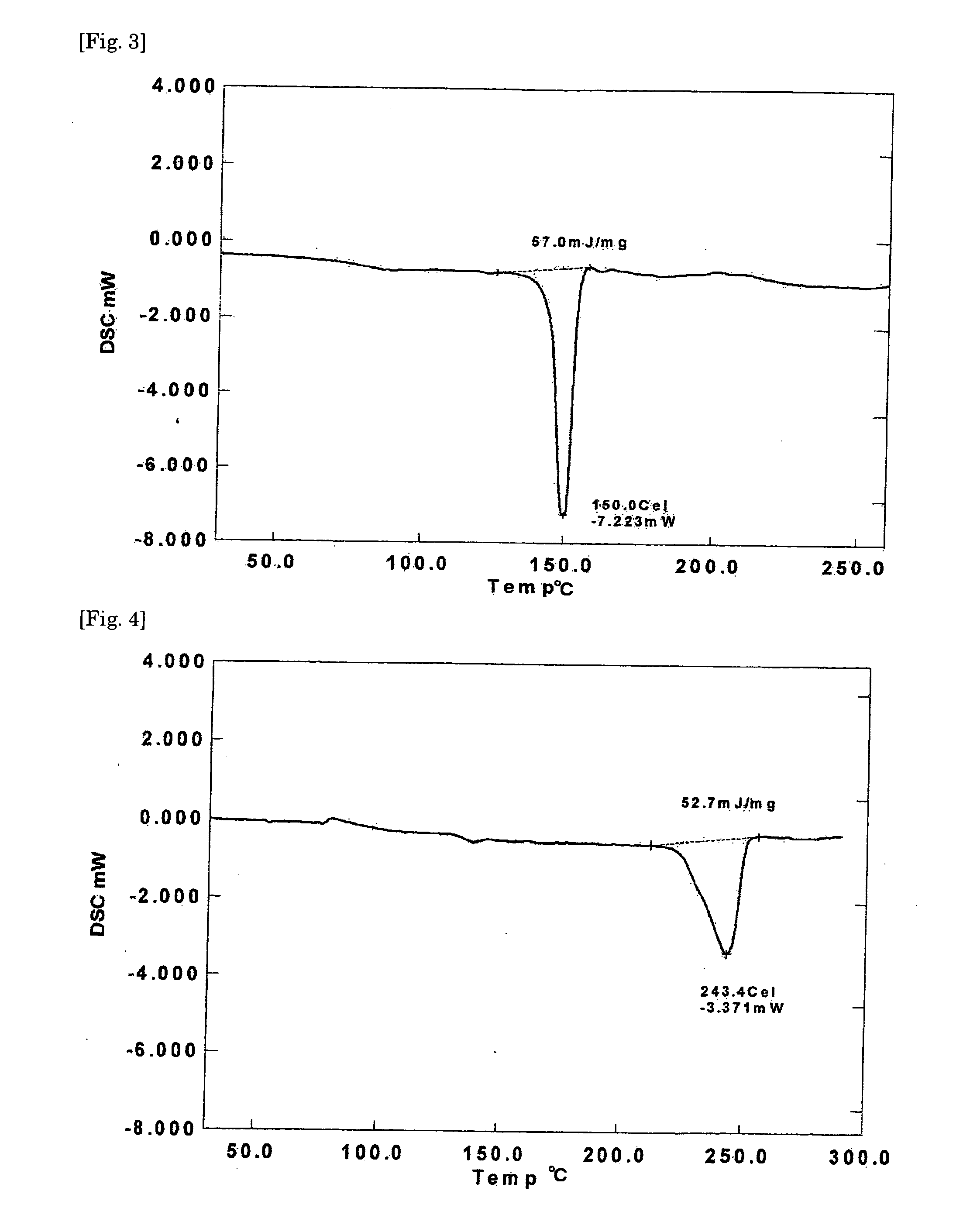Crystalline resin cured product, crystalline resin composite material, and method for producing the same
a technology of crystalline resin and cured products, which is applied in the field of crystalline resin cured products and crystalline resin composite materials, and the method of producing the same, can solve the problems of low heat expansion, low thermal expansion, and insufficient heat conductivity of cured products obtained so far from conventional epoxy resins, and achieves low thermal expansion, high heat resistance, and high heat resistance. high
- Summary
- Abstract
- Description
- Claims
- Application Information
AI Technical Summary
Benefits of technology
Problems solved by technology
Method used
Image
Examples
synthetic example 1
[0076]In 3690 g of epichlorohydrin was dissolved 576 g of 4,4′-dihydroxydiphenyl ether and to the solution was added dropwise 48% sodium hydroxide solution under reduced pressure (at approximately 120 mmHg) at 60° C. over 4 hours. In the meantime, the water formed was removed from the system by azeotropic distillation with epichlorohydrin and the distilled epichlorohydrin was returned to the system. Upon completion of the dropwise addition, the reaction was continued for 1 hour. Thereafter, the epichlorohydrin was distilled off under reduced pressure, the remainder was dissolved in 2090 g of methyl isobutyl ketone, and the salt formed was removed by filtration. Then, 68 g of 20% sodium hydroxide solution was added and the reaction was allowed to proceed at 80° C. for 2 hours. The reaction mixture was filtered, washed with water, and stripped of the solvent methyl isobutyl ketone by distillation under reduced pressure to give 825 g of a diglycidyl resin (diglycidyl resin A) as light ...
synthetic example 2
[0077]In a 500-ml four-necked flask equipped with a stirrer, a thermometer, a condenser, and a gas inlet tube for nitrogen were placed 245 g of diglycidyl resin A prepared in Synthetic Example 1 and 38 g of 4,4′-dihydroxydiphenyl ether and melt-mixed with stirring at 150° C. in a stream of nitrogen, 0.12 g of triphenylphosphine was added, and the mixture was allowed to react for 2 hours to give 281 g of a diglycidyl resin. The diglycidyl resin (diglycidyl resin B) thus obtained crystallized when allowed to cool to room temperature. The resin showed an epoxy equivalent of 261 g / eq., a melting point of 100-122° C. determined by the capillary method, and a viscosity of 0.037 Pa·s at 150° C. The ratio of the resin components in terms of the ratio of n in general formula (1) was determined by GPC measurements: n=0, 45.8%; n=2, 28.0%; n=4, 12.3%; and n≧6, 13.9%. The viscosity was measured with the aid of Rheomat 115, a viscometer manufactured by Contraves Industrial Products, Ltd. The GPC...
synthetic example 3
[0078]In 3240 g of epichlorohydrin and 650 g of diethylene glycol dimethyl ether was dissolved 500 g of 4,4′-dihydroxydiphenylmethane and to the solution was added dropwise 48% sodium hydroxide solution under reduced pressure (at approximately 120 mmHg) at 60° C. over 4 hours. In the meantime, the water formed was removed from the system by azeotropic distillation with epichlorohydrin and the distilled epichlorohydrin was returned to the system. Upon completion of the dropwise addition, the reaction was continued for 1 hour. Thereafter, the epichlorohydrin and the diethylene glycol dimethyl ether were distilled off under reduced pressure, the remainder was dissolved in 1800 g of methyl isobutyl ketone, and the salt formed was removed by filtration. Then, 60 g of 20% sodium hydroxide solution was added to the filtrate and the mixture was allowed to react at 80° C. for 2 hours. The reaction mixture was then filtered, washed with water, and stripped of the methyl isobutyl ketone by dis...
PUM
| Property | Measurement | Unit |
|---|---|---|
| melting point | aaaaa | aaaaa |
| melting point | aaaaa | aaaaa |
| temperature | aaaaa | aaaaa |
Abstract
Description
Claims
Application Information
 Login to View More
Login to View More - R&D
- Intellectual Property
- Life Sciences
- Materials
- Tech Scout
- Unparalleled Data Quality
- Higher Quality Content
- 60% Fewer Hallucinations
Browse by: Latest US Patents, China's latest patents, Technical Efficacy Thesaurus, Application Domain, Technology Topic, Popular Technical Reports.
© 2025 PatSnap. All rights reserved.Legal|Privacy policy|Modern Slavery Act Transparency Statement|Sitemap|About US| Contact US: help@patsnap.com



